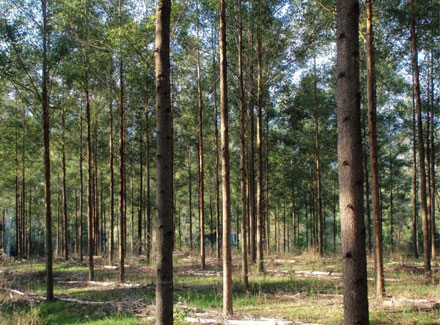
Tasmanian farmers have jumped on the ever-growing demand for timber, establishing private plantations on their properties. Source: ABC News
Graham Freeman was taking a punt when he planted a broken hillside on his property at Milabena, in north-west Tasmania, with sequoia redwoods — a tree that grows to towering heights in northern California.
“I wasn’t driven by potential monetary gains put it that way, it was just having an interest in those things,” Mr Freeman said. “Mind you, you want to try and grow a few things that might bring you some money in the long run.”
Mr Freeman is one of a handful of farmers in Tasmania who have established small plantations on their properties.
In a state that lived through the so-called “forestry wars” for decades, stirring up interest in tree farming is not always easy. The state-funded group Private Forests Tasmania (PFT) and the CSIRO have launched a research project examining the state’s agroforestry sector — looking to ultimately entice more people into the industry.
Martin Moroni from PFT says with demand for timber increasing worldwide, farmers and landholders are well-placed to capitalise if they get into the market.
“Essentially we need more resource planted in the privately-owned areas of the state to provide more wood to the industry,” he said.
Researchers are trying to quantify the beneficial flow-on effects of planting trees — focusing on shelter for stock and crops, increasing land values and promoting biodiversity. Roger Poltock has had particular success with planting radiata pine on his property at Wilmot, north of Cradle Mountain.
He first established the plantation 1986 and has since built up others around the property, many in the form of shelter belts to protect his grazing beef cattle from Tasmania’s unpredictable elements.
Mr Poltock also recently won a national tree farming award.
A geologist of many years, Mr Poltock has a keen eye for ground that will not work for traditional farming.
“In the Wilmot area there’s a lot of rock types that surface that have fairly poor surface on them for growing crops and grass and they’re also the areas that I’ve established the trees,” he said. “I can see lots of parts of farms around here [that] if they were mine, I’d put trees in there and they would be more productive.”
Social scientist at CSIRO, Aysha Fleming, said understanding the emotions around trees is key to encouraging more farmers to establish their own plantations.
“If you do decide or you want to have the option to harvest the trees, there’s so much uncertainty about what type of return are you going to be able to get,” she said.
“One of the problems is trees are longer-term, so if things don’t go well or you haven’t got them in quite the right place or quite the right species, its quite hard to change.
“So it does involve a little bit more planning than some of your other types of farming decisions.”
Last financial year, there was a 32% increase in private forest production in Tasmania. The general consensus in the industry is that times are good, and demand is predicted to keep growing.
Mr Moroni believes the world’s growing population, and an increasing need for sustainability, will result in a huge need for a timber supply.
“Internationally wood is being used to build car bodies, to build motherboards, it can make plastic, it can make fuels,” Mr Moroni said. “The array of things that are coming including pharmaceuticals and biochemicals is really exciting.”
Mr Freeman knows with a few more decades, his redwoods could get a top-dollar price as veneer timber.
He keeps a “rough eye” on market prices for wood products, and has lamented the lack of any government incentives to offset the cost of establishing for newcomers.
“One of the benefits of a crop of trees is the fact that if the prices are not quite so good this year — you know, it’s not like a crop of peas and you have to harvest it, you can wait another five or six years,” he said.







